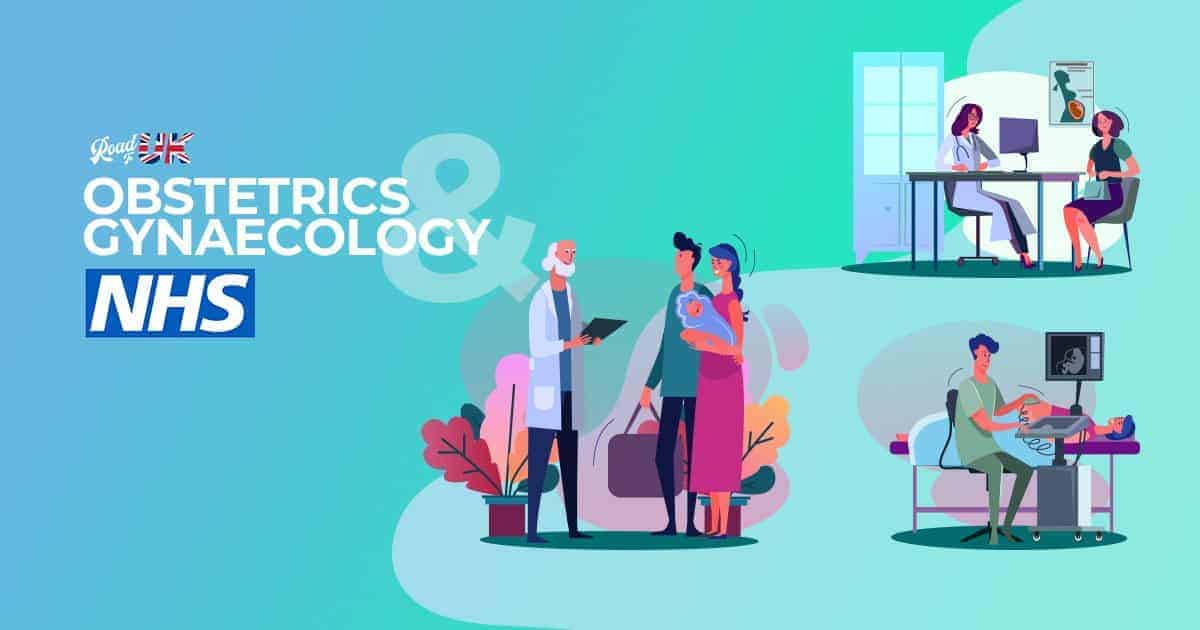Working in Obstetrics & Gynaecology (OB/GYN) in the NHS

Obstetrics and Gynaecology is a varied speciality providing a unique blend of medicine and surgery in the NHS. It provides a wide range of care to women- including fertility, reproduction, post-menopausal concerns including bleeding. Although demanding, it is an extremely rewarding career allowing a brilliant blend of medicine, surgery and the development of several adaptable skills including ultrasound.
What can you expect?
Although categorized in one department, there are various departments within this branch that deals with different problems:
Obstetrics
As per RCOG, obstetrics involves advanced antenatal and labour ward practise, fetal medicine, labour ward lead and maternal medicine. It is a multidisciplinary department that involves the close working of obstetricians, midwives and anaesthetists.
Midwives are highly skilled health care professionals who receive training exclusively in the care of pregnant women, new mothers and newborns. They are a key member of the team- with their share of workload and experience, they are usually the first to raise concerns if anything appears amiss. It is usually a wise idea to ask the midwife what her concerns are before reviewing a patient.
Most antenatal care and delivery in the UK is midwifery-led unless there are concerns antenatally and/or during labour. Pregnant women requiring medical review are seen in antenatal clinics or wards in the hospital (depending on urgency) where they are seen by obstetricians. All patients admitted to the antenatal and labour wards are reviewed by the obstetricians and they intervene in labour management if any concerns and for scheduled cesarean sections.
Postnatal review of the new mother is not common (unless complicated or asked)- although it is usually done 6-8 weeks postnatally, in combination with the neonatal check.
Gynaecology
As per RCOG, gynaecology includes acute gynaecology and early pregnancy, abortion care, colposcopy, menopause, vulval disease- just to name a few. Another important branch of gynaecology includes Gynaecology Oncology, Urogynaecology.

Daily Tasks on the Ward
It is important to remember that every hospital is different and therefore responsibilities vary with each hospital. I am sharing the duties I was expected to do as obstetrics & gynaecology SHO in the NHS and hopefully, this will give a general idea.
Obstetrics SHO on call
- Attend handovers- day/night registrar handover ongoing cases from their respective shifts.
- Attend rounds on labour ward- patients who are currently in labour. Interestingly, ward rounds in maternity are slightly different compared to hospital ward rounds. The Consultant, registrar and SHO go to each room where they receive the history and current situation by the midwife assigned to the patient. During the day, tasks include basic SHO duties including cannulas, filling drug charts, reviewing patients that midwives are concerned about (will mention common concerns below), assisting in cesarean sections.
- Review of patients in the postnatal ward- review of new mothers highlighted by concerned midwives, medication review.
- Review of patients in antenatal ward- this includes review of patients who are undergoing induction, ruptured membranes or have required admission due to medical concerns due to pregnancy.
You aren’t expected to attend all the wards by yourself. Depending on the staff, you may have other SHOs covering one or more wards. If no one else is available, your registrar and consultant will review the labour ward while you review the antenatal or postnatal ward.
After ward rounds, if you don’t remember a patient, no worries! Midwives are extremely helpful and well aware of their patient’s history and ongoing management. In addition, there is a board in the nurse’s station with summaries of each patient and ongoing management- in case you need a quick reminder.

Gynaecology SHO on call
- Attend handovers
- Attend and clerk patients in A&E (if unwell) or SAU (surgical assessment unit)
- Make management plans and discuss/escalate to seniors if any concern
- Review admitted patients and make appropriate plans
- Assist in theatres, if required
- Update handover lists
Gynaecology Oncology SHO on call
Although a part of the department, gynaecology oncology work is separate from the other two. Their work involves clinics, MDT meetings and theatre. They usually manage oncology and review postmenopausal bleeding in clinics. When part of the team (as part of rotation), jobs include:
- Reviewing admitted patients including post-operative.
- Follow up of bloods and scans of patients and update consultants appropriately
- Assist in theatres
- Participate in MDT meetings
- As part of learning, you can attend clinics including colposcopy, hysteroscopy, postmenopausal bleeding clincs.
Common Cases in Obstetrics & Gynaecology in the NHS
Antenatal
- UTI, pyelonephritis
- Symphysis pubis dysfunction
- Gestational hypertension vs preeclampsia
- PV bleeding- in labour or other causes (midwives do this themselves but this is depending on Trust)
- Pulmonary Embolism, deep vein thrombosis
On labour ward
- Pre-eclampsia (presenting with headache, RUQ pain, raised blood pressure, proteinuria, decreased urine output)
- Fever/Sepsis
- Elevated HR, BP
- Pulmonary Embolism, deep vein thrombosis
- Abnormal CTGs (usually reviewed by Registrars but again, this is Trust dependant)

Postnatal
It’s important to remember that the postnatal period extends to 6 weeks postpartum.
- Preeclampsia
- Fever/sepsis
- Unresolving abdominal pain
- Review of cesarean or episiotomy scar
- Endometritis
As a Gynaecology SHO
- Miscarriages (PV bleeding, abdominal pain)
- Ectopic pregnancy
- Hyperemesis gravidarum
- Pelvic inflammatory disease
- Bartholin cysts
- Loss of Mirena coil thread
- Postmenopausal bleeding (which will likely be handed to the gynaecology oncology team eventually)
Clinics in Obstetrics & Gynaecology
Early Pregnancy Assessment Centre (Early Pregnancy Assessment Unit) – EPAC/EPAU
This is a clinic that reviews and scans early pregnancies- up to 12 weeks. This is a referral only system and scans women up to 12 weeks pregnant and have symptoms like abdominal pain or PV bleeding to detect the state of pregnancy. It is usually run by midwives and they refer patients to the gynaecologists if any concerns.

Rapid Access Clinic (RAC)
This is a gynaecology clinic to which referrals (usually 2-week wait referrals) are made concerning symptoms or unusual findings on scans that do not require acute/emergency review.
Skills to sharpen while working in obstetrics & gynaecology in the NHS
While working in Obstetrics and Gynaecology in the NHS, there are numerous skills you will learn which can be adapted in other departments:
Breaking bad news
Like other medical departments, you may have to, unfortunately, break the bad news to patients (especially with miscarriages, failed pregnancy, ectopic pregnancy). While this is usually done by seniors, situations arise which may lead you to do it. While there is no correct way to do it, (in my opinion) the best way to learn is to watch a senior do it a couple of times. Initially, you may struggle but with time, you will develop your own way.
Theatre
As an SHO, one of the duties is to assist in theatres. This is the perfect opportunity to build your surgical skills if you are interested in doing so- initially by assisting, then closing skin and then gradually performing the cesarean section as chief surgeon. Other opportunities also include repair of episiotomies and perineal tears- they are usually done by the midwives but if complex requires a doctor to repair. You also assist in laparoscopic surgeries like hysterectomies, salpingectomy etc.
Rotation in Obstetrics & Gynaecology as a GP Trainee
Obstetrics and Gynaecology is a common hospital rotation for GP trainees. In fact, during my placement, the number of GP trainees far outnumbered gynaecology trainees! This placement provides you with ample opportunities to complete your Workplace Based Assessments.
Things to learn as a GP trainee
CLINICAL EXAMINATION AND PROCEDURAL SKILLS (CEPS)
This rotation provides a perfect opportunity to complete CEPS for 2 of the basic intimate examinations required- breast and female genital examination- including speculum and bimanual pelvic examination.
CASE BASED DISCUSSIONS (CbDS)
These can be based on any case seen but some useful examples include ovarian cysts, postmenopausal bleeding, miscarriage.
Mini-CEX (CLINICAL EVALUATION EXERCISE)
There are ample opportunities to collect evidence for your portfolio by asking your registrar to supervise you while you are evaluating a patient including determining a diagnosis and formulating a plan. Another example for miniCEX also includes breaking bad news or explaining a diagnosis and management plan to a patient.
How to become an obstetrician and gynaecologist in the UK
If you meet the requirements for the training program, you can apply for it. After being long-listed, you will be invited to give the MSRA exam which contributes to 25% of your total score. After the exam, you will be invited for the Interview. The interview consists of three stations, each lasting 15 minutes-
- Clinical Station
- Communication Station
- Structured Interview Station
Each station is worth 50 and is scored by 2-panel members each. You must score 25 or above in each station in order to be considered appointable.
Read this article to know further about Specialty Training in Obstetrics & Gynaecology

In conclusion, obstetrics and gynaecology can be a very rewarding job. It is a fast-paced and varied job- one minute you’ll be running to the theatre for an emergency C-section while receiving calls from A&E and the next hour it may be quiet. A lot of people are put off by the duration of the training and the demands of the job. However, with various options provided like less than full time (LTFT) for training, it is easy to complete the training without being exhausted. It is a great place to be if you enjoy medicine and surgery and don’t want to give up either skill.

